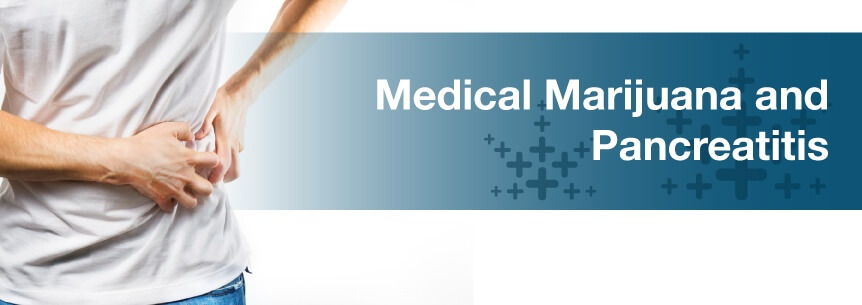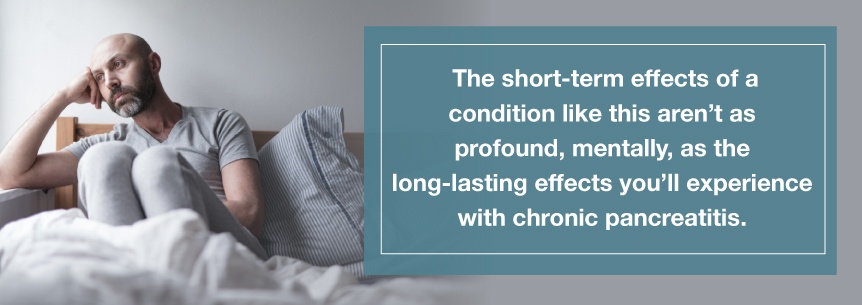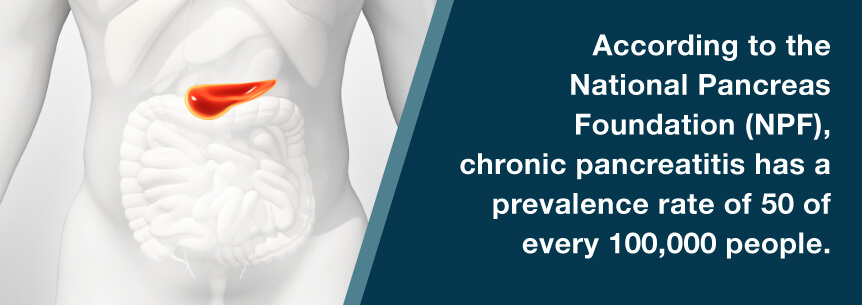
Those struggling with pain and inflammation that comes with pancreatitis welcome any type of relief. While certain medications can help alleviate pain and reduce inflammation, they can also come with harsh side effects. Thankfully, cannabis can be an alternative treatment method to ease these and other pancreatitis symptoms but doesn’t carry the same risks.
First, there is a potential risk factor for acute and chronic pancreatitis for people under 35 years old who use cannabis. Therefore, if you have idiopathic acute pancreatitis, you should consider toxicology screens.
Two areas where medical marijuana could be helpful for pancreatitis include

Currently, doctors prescribe opioids for pain, but, as you may be well aware, there’s a serious opioid-abuse epidemic in the nation. So, substituting cannabis for opioids could be advantageous in relieving the pain involved in acute or chronic pancreatitis.
Find A Doctor Find A Dispensary
Aside from pain and inflammation, medical marijuana can help with the following pancreatitis symptoms:
In smaller studies, those who used THC showed the improved sense of well-being, improved mood, improved sleep and reduced anxiety.
Another study where healthy participants ingested medical weed showed cannabinoid preparations had an immunosuppressive effect. Results of the study were related to both long-term and short-term effects in those suffering from chronic pancreatitis-related abdominal pain (or other causes) and receiving medical cannabis preparation.
Below are various medical cannabis strains that may be useful for pancreatitis and their different effects.
All cannabis plants derive from two families — sativa and indica. Both of these help reduce pain. However, indica strains help with more extensive aches and pain due to their full-body effect. They sedate and relax you whereas you get a more energizing and stimulating effect with sativa strains. Since indicas affect your entire body, they make a better option for treating chronic pain. Some recommended strains for pain include:
As mentioned, marijuana treatment is associated with reducing both pain and inflammation — generally due to its CBD and THC cannabinoids. Some good strains for inflammation include:
Medical cannabis can help with nausea, no matter if it’s due to your pancreatitis or the different treatments for it. Some strains to experiment with for nausea and vomiting include:
Some good all-around strains for other symptoms like headache, insomnia, depression, anxiety and more include:
Speak with an experienced budtender or cannabis doctor for some other strain recommendations.
With the medical cannabis industry evolving, doctors and patients are looking for more effective ways of consuming the herb in treatment. And, fortunately, bongs and joints aren’t their only options anymore.
Although some users still seem to favor these methods, they’re starting to lose out in favor of more high-tech, safer consumption options. Not to mention, many individuals are also leery of smoking cannabis because of the potential risk of lung irritation, respiratory illness and possibly cancer (although there’s very limited research on these risks).
Below are some suggested healthier methods of consuming your cannabis treatment other than smoking that could benefit you but without the risks of inhaling the herb.
Vaping cannabis is also an alternative to smoking weed.
Pancreatitis, whether acute or chronic, can be a painful condition that comes with other undesirable symptoms, such as nausea, vomiting, and anxiety. If you’re seeking a medical marijuana card for pancreatitis, and live in a state where medical pot is legal, set up your appointment with a qualified cannabis doctor at MarijuanaDoctors.com and browse our vast dispensary list to find one near you.
Find A Doctor Find A Dispensary
Pancreatitis occurs when your pancreas, an abdominal gland located in the upper abdomen behind the stomach, becomes inflamed. Its primary function is to convert food into fuel for the body through two main functions:
Inflammation of your pancreas often occurs as a result of a buildup of pancreatic enzymes that begin to attack and digest the organ itself.
There are two primary types of pancreatitis. The severity and longevity of the condition determine the kind of pancreatitis you have.
The following symptoms are common among people who have both acute and chronic pancreatitis.
Almost everyone who has pancreatitis experiences the symptoms listed above. If you suffer from chronic pancreatitis, you may have additional symptoms, such as:
Pancreatitis is a serious illness. Both types of pancreatitis can cause lasting damage to your pancreas if treatment is delayed or prolonged unnecessarily. However, if you’re experiencing the following three symptoms, you should seek medical treatment right away.
If left untreated, chronic pancreatitis can become fatal.
Your doctor may prescribe a panel of blood tests, specifically testing for pancreatic enzyme levels, as well as the following types of tests to diagnose pancreatitis:
The tests are mostly non-invasive and can help your doctor determine the nature of your condition and gain insights into potential causes of your pancreatitis.
One of the most common causes of acute pancreatitis is gallstones, according to the U.S. National Library of Medicine (NLM). Further, Johns Hopkins Medicine reports that over 80 percent of acute pancreatitis involves alcohol use or biliary stones.
Other causes of acute pancreatitis include:
About 70 percent of chronic pancreatitis cases are attributable to long-term alcohol use.
Other causes of chronic pancreatitis are:
The National Institute of Diabetes and Digestive and Kidney Diseases (NIDDK) suggests that people with the following health conditions and concerns may have a greater likelihood of developing pancreatitis:
Women have biliary pancreatitis more frequently than men, but men have alcohol-induced acute pancreatitis more often than women.
Also, people who smoke or drink heavily are also at risk of developing pancreatitis.
Pancreatitis may result in you experiencing several symptoms including:
Because the pancreas is instrumental in helping your body break down and digest food and sugars in the body, if it is not functioning as it should, you may develop diabetes as a result of pancreatitis.
In cases of chronic pancreatitis, weight loss is a common side effect due to the body’s inability to absorb food and nutrients. Without proper treatment, your condition will worsen and may ultimately lead to death.
Any chronic illness is taxing on the body and the mind. Pancreatitis is no different. The short-term effects of a condition like this aren’t as profound, mentally, as the long-lasting effects you’ll experience with chronic pancreatitis.

Long-term pain, like that associated with chronic pancreatitis, may cause depression. The digestive issues may cause anxiety when around other people or the fear of going out and participating in normal activities. These things can lead to feelings of loneliness and isolation that exacerbate depression.
Several organizations provide statistics on pancreatitis.

Whether you have acute or chronic pancreatitis, you need professional medical treatment. Because it is an infection, antibiotic medications are the cornerstones of treatment. Dehydration often runs hand-in-hand with the condition, requiring fluid or electrolyte replacement.
Common treatments for pancreatitis include a variety of options and depend largely on the type of pancreatitis you’re experiencing.
Acute pancreatitis treatments include:
In some cases, physicians may recommend the removal of the gallbladder to prevent the creation of new gallstones. If the symptoms of acute pancreatitis are severe or the area is too tender, physicians may wait until after the tenderness and swelling subside before removing the gallbladder. Gallbladder surgery can involve the risk of infection.
Mild acute pancreatitis often requires a short-term hospital stay while moderate cases require more extended hospitalization periods.
Chronic pancreatitis often has more severe symptoms. For this reason, more extensive treatments may be required, including one or more of the following:
In some cases, endoscopic retrograde cholangiopancreatography (ERCP) can be used by physicians to view what’s going on in the bile and pancreatic ducts. It may be used to remove bile duct gallstones that may be causing blockages. The procedure combines x-rays with a gastrointestinal endoscopy to treat the pancreatic and bile ducts.
Chronic pancreatitis often requires intensive care treatment. The more you know about the condition, how doctors treat it and the steps you can take to avoid pancreatitis, the better your odds of receiving prompt medical attention and achieving a swift recovery will be.
The National Pancreas Foundation recommends several complementary treatments to use in conjunction with medically prescribed treatments for pancreatitis, such as:

For most people, these treatments do not have side effects.
While there have been many developments in pancreatitis treatments, one advanced treatment offers favorable results using enteral nutrition with acute pancreatitis patients, even early in the course of the disease.
Enteral nutrition is sometimes called tube feeding because liquid nutrients are delivered to the GI (gastrointestinal) tract via a tube. This tube can be nasogastric — inserted through your nose and going into your stomach — or directly into your stomach through your skin.